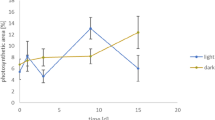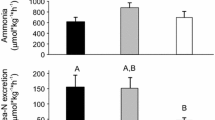Summary
The trophic strategies were studied of Heteroxenia fuscescens living in shallow tropical waters. Structural and physiological adaptations show that particulate food is of less nutritional importance than the uptake of organic material dissolved in the sea, the utilization of assimilates of cytosymbiotic algae (zooxanthellae) and even the symbionts themselves. The external and internal surfaces of the tentacles are enlarged by featherlike pinnules, on the one hand facilitating the epidermal uptake of dissolved organic compounds and on the other offering wellilluminated spaces in which large numbers of zooxanthellae can be ‘cultivated’.
Zooxanthellae expelled from gastrodermal cells may be taken up by the mesenteric filaments of the dorsal mesenteries, where they are often decomposed and utilized. The transport of photo-assimilates from the gastrodermis to the epidermis through the mesogloea takes place at a low rate. Most of the released assimilates of the symbionts appear in the coelenteron. One fraction of these assimilates is distributed within the gastric channel system and can be taken up by developing stages living there; another fraction reaches the epidermis extracorporally via the pharynx and the sea. Thus both the pharynx and the epidermis absorb these photo-assimilates. The epidermal uptake capacity serves two main purposes: (1) active uptake and incorporation of external organic material dissolved in the sea; (2) reabsorption of internal, self-produced organic material, i.e. reduction of the loss of endogenous compounds escaping from the gastric cavity necessarily due to the polyfunctionality of the coelenteron.
Similar content being viewed by others
References
Gohar HAF (1940a) Studies on the Xeniidae of the Red Sea: Their Ecology, Physiology, Taxonomy and Phylogeny. Publ Mar Biol Stat Ghardaga 2:24–125
Gohar HAF (1940b) The development of some Xeniidae (Alcyonaria), with some ecological aspects. Publ Mar Biol Stat Ghardaqa 3:26–79
Gomme J (1981) Recycling of D-glucose in collagenous cuticle: a means of nutrient conservation? J Membrane Biol 62:47–52
Muscatine L (1974) Endosymbiosis of cnidarians and algae. In: Coelenterate Biology, L. Muscatine and H.M. Lenhoff (eds). Academic Press, pp 359–395
Muscatine L, Pool RR, Cernichiari E (1972) Some factors influencing selective release of soluble organic material by zooxanthellae from reef corals. Mar Biol 13:298–308
Muscatine L, Porter JW (1977) Reef corals: mutualistic symbioses adapted to nutrient-poor environments. BioScience 27:454–460
Schlichter D (1973) Ernährungsphysiologische und ökologische Aspekte der Aufnahme in Meerwasser gelöster Aminosäuren durch Anemonia sulcata (Coelenterata, Anthozoa). Oecologia (Berl) 11:315–350
Schlichter D (1980) Adaptations of cnidarians for integumentary absorption of dissolved organic material. Rev Can Biol 39:259–283
Schlichter D Nutritional strategies of cnidarians: the absorption, translocation and utilization of dissolved nutrients by Heteroxenia fuscescens. Am Zool (in press)
Taylor DL (1974) Symbiotic marine algae: taxonomy and biological fitness. In: Symbiosis in the sea, WB Vernberg (ed), Columbia Univ South Carolina Press, pp 245–262
Thorington G, Margulis L (1981) Hydra viridis: Transfer of metabolites between Hydra and symbiotic algae. Biol Bull 160:175–188
Trench RK (1971) The physiology and biochemistry of zooxanthellae symbiotic with marine coelenterates. II. Liberation of fixed 14C by zooxanthellae in vitro. Proc R Soc London Ser B 177:237–250
Trench RK (1974) Nutritional potentials in Zoanthus sociathus (Coelenterata, Anthozoa). Helg wiss Merresu 26:174–216
Trench RK (1979) The cell biology of plant-animal symbiosis. Ann Rev Plant Physiol 30:485–531
Author information
Authors and Affiliations
Rights and permissions
About this article
Cite this article
Schlichter, D. Epidermal nutrition of the alcyonarian Heteroxenia fuscescens (Ehrb.): absorption of dissolved organic material and lost endogenous photosynthates. Oecologia 53, 40–49 (1982). https://doi.org/10.1007/BF00377134
Received:
Issue Date:
DOI: https://doi.org/10.1007/BF00377134




